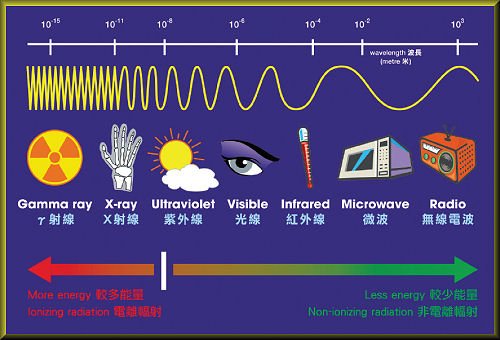Non-ionizing radiation is all around us and comes from both natural and human-made sources. It includes electric and magnetic fields, radio waves, microwaves, infrared, ultraviolet, and visible radiation. Workers can effectively limit their exposure to non-iodizing radiation by shielding and by keeping a safe distance from sources.

How workers are exposed
Most people aren’t aware they are being exposed to non-ionizing radiation. There are many types of non-ionizing radiation, which include:
| Ultraviolet light |
|
| Visible light |
|
| Infrared light |
|
| Microwave radiation |
|
| Radio frequency radiation |
|
| Extremely low frequency radiation |
|
Some jobs expose workers to more non-ionizing radiation than others. Higher exposure work includes:
- Maintenance on radio, cell or TV towers
- Roofing
- Painting
- Building maintenance
- Building inspection
- Window washing
- Welding
- Glassmaking
- Furnaces
- Outdoor workers
The dangers to workers
Each type of radiation causes different effects on human tissue. The closer workers are to the source of the non-ionizing radiation, the more exposure they will experience. Fortunately, non-ionizing radiation hasn’t been demonstrated to cause cancer or other serious illnesses, with the exception of sunlight causing skin cancers. The International Agency for Research on Cancer has classified radiofrequency and microwave electromagnetic fields as possible carcinogenic to humans (Group 2B) based on an increased risk for two types of tumours (glioma and acoustic neuroma).
The most common health effects workers may experience depend on the type of radiation they are exposed to:
| Extremely low frequency radiation |
|
| Radio frequency radiation and microwave radiation |
|
| Ultraviolet radiation |
|
| Infrared radiation |
|
How to reduce the risks
The best way to reduce the risk of exposure to non-ionizing radiation is to eliminate the source of exposure. If that’s not possible, there are other risk controls to use which will be identified in your exposure control plan. To protect workers from discreet sources, creating distance between them and the source of the non-iodizing radiation is often effective. As the worker moves away, exposure quickly decreases. If the source is not from a specific location or increasing the distance from the source is not possible, shielding might be appropriate.
When choosing risk controls, start by asking the questions in the following steps, listed in order of effectiveness.
- Engineering controls
Making physical modifications to facilities, equipment, and processes can reduce exposure. Some questions to consider:
- Can guards or barriers be used to restrict access to high exposure areas?
- Can antennas be raised so they are above the working level of the roof?
- Can shields be erected to eliminate nearby workers from exposure?
- Administrative controls
Changing work practices and work policies, and using awareness tools, and training, can limit the risk of non-ionizing radiation exposure. Some questions to consider:
- Can the equipment be turned off to do work around it?
- Is access to communication and data transmitting equipment secured or restricted?
- Can warning signs be posted to indicate high radiation areas?
- Can the amount of time workers spend near the antenna be limited?
- Can a notification system be set up to alert contractors when an antenna is present?
- Is a UV protection program in place?
- Personal protective equipment
This is the least preferred control. It must always be used in addition to at least one other control. Some questions to consider:
- Do workers have the proper eye wear and protective clothing?
- Has personal protective equipment been verified to ensure it is working properly?
- Is sunscreen provided?




One thought on “Non-ionizing Radiation”